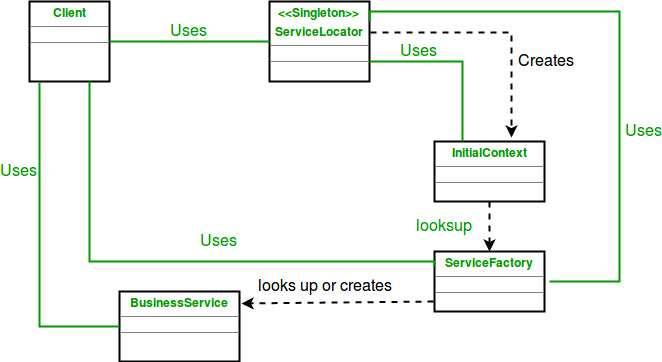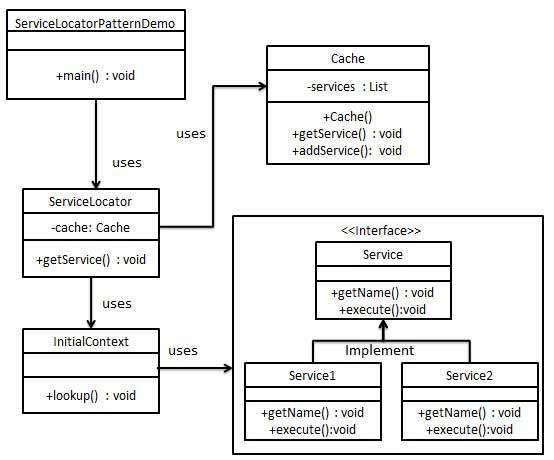Service Locator Pattern 服务定位
https://www.geeksforgeeks.org/service-locator-pattern/



Service Locator Pattern
Last Updated: 06-03-2018
The service locator pattern is a design pattern used in software development to encapsulate the processes involved in obtaining a service with a strong abstraction layer. This pattern uses a central registry known as the “service locator” which on request returns the information necessary to perform a certain task.
The ServiceLocator is responsible for returning instances of services when they are requested for by the service consumers or the service clients.
- Service Locator : The Service Locator abstracts the API lookup services, vendor dependencies, lookup complexities, and business object creation, and provides a simple interface to clients. This reduces the client’s complexity. In addition, the same client or other clients can reuse the Service Locator.
- InitialContext : The InitialContext object is the start point in the lookup and creation process. Service providers provide the context object, which varies depending on the type of business object provided by the Service Locator’s lookup and creation service.
- ServiceFactory : The ServiceFactory object represents an object that provides life cycle management for the BusinessService objects. The ServiceFactory object for enterprise beans is an EJBHome object.
- BusinessService : The BusinessService is a role that is fulfilled by the service the client is seeking to access. The BusinessService object is created or looked up or removed by the ServiceFactory. The BusinessService object in the context of an EJB application is an enterprise bean.
Suppose classes with dependencies on services whose concrete types are specified at compile time.
In the above diagram, ClassA has compile time dependencies on ServiceA and ServiceB.But this situation has drawbacks.
- If we want to replace or update the dependencies we must change the classes source code and recompile the solution.
- The concrete implementation of the dependencies must be available at compile time.
By using the Service Locator pattern :
In simple words, Service Locator pattern does not describe how to instantiate the services. It describes a way to register services and locate them.
Let’s see an example of Service Locator Pattern.
edit
play_arrow
brightness_4
// Java program to // illustrate Service Design Service // Locator Pattern import java.util.ArrayList; import java.util.List; // Service interface // for getting name and // Executing it. interface Service { public String getName(); public void execute(); } // Service one implementing Locator class ServiceOne implements Service { public void execute() { System.out.println("Executing ServiceOne"); } @Override public String getName() { return "ServiceOne"; } } // Service two implementing Locator class ServiceTwo implements Service { public void execute() { System.out.println("Executing ServiceTwo"); } @Override public String getName() { return "ServiceTwo"; } } // Checking the context // for ServiceOne and ServiceTwo class InitialContext { public Object lookup(String name) { if (name.equalsIgnoreCase("ServiceOne")) { System.out.println("Creating a new ServiceOne object"); return new ServiceOne(); } else if (name.equalsIgnoreCase("ServiceTwo")) { System.out.println("Creating a new ServiceTwo object"); return new ServiceTwo(); } return null; } } class Cache { private List<Service> services; public Cache() { services = new ArrayList<Service>(); } public Service getService(String serviceName) { for (Service service : services) { if (service.getName().equalsIgnoreCase(serviceName)) { System.out.println("Returning cached " + serviceName + " object"); return service; } } return null; } public void addService(Service newService) { boolean exists = false; for (Service service : services) { if (service.getName().equalsIgnoreCase(newService.getName())) { exists = true; } } if (!exists) { services.add(newService); } } } // Locator class class ServiceLocator { private static Cache cache; static { cache = new Cache(); } public static Service getService(String name) { Service service = cache.getService(name); if (service != null) { return service; } InitialContext context = new InitialContext(); Service ServiceOne = (Service)context.lookup(name); cache.addService(ServiceOne); return ServiceOne; } } // Driver class class ServiceLocatorPatternDemo { public static void main(String[] args) { Service service = ServiceLocator.getService("ServiceOne"); service.execute(); service = ServiceLocator.getService("ServiceTwo"); service.execute(); service = ServiceLocator.getService("ServiceOne"); service.execute(); service = ServiceLocator.getService("ServiceTwo"); service.execute(); } } |
Output:
Creating a new ServiceOne object
Executing ServiceOne
Creating a new ServiceTwo object
Executing ServiceTwo
Returning cached ServiceOne object
Executing ServiceOne
Returning cached ServiceTwo object
Executing ServiceTwo
Advantages :
- Applications can optimize themselves at run-time by selectively adding and removing items from the service locator.
- Large sections of a library or application can be completely separated. The only link between them becomes the registry.
Disadvantages :
- The registry makes the code more difficult to maintain (opposed to using Dependency injection), because it becomes unclear when you would be introducing a breaking change.
- The registry hides the class dependencies causing run-time errors instead of compile-time errors when dependencies are missing.
Strategies
The following strategies are used to implement service Locator Pattern :
- EJB Service Locator Strategy : This strategy uses EJBHome object for enterprise bean components and this EJBHome is cached in the ServiceLocator for future use when the client needs the home object again.
- JMS Queue Service Locator Strategy : This strategy is applicable to point to point messaging requirements. The following the strategies under JMS Queue Service Locator Strategy.
- JMS Queue Service Locator Strategy
- JMS Topic Service Locator Strategy
- Type Checked Service Locator Strategy : This strategy has trade-offs. It reduces the flexibility of lookup, which is in the Services Property Locator strategy, but add the type checking of passing in a constant to the ServiceLocator.getHome() method.
Design Pattern - Service Locator Pattern - Tutorialspoint https://www.tutorialspoint.com/design_pattern/service_locator_pattern.htm

Service Locator Pattern 服务定位的更多相关文章
- .NET 服务器定位模式(Service Locator Pattern)——Common Service Locator
本文内容 场景 目标 解决方案 实现细节 思考 相关模式 更多信息 参考资料 Common Service Locator 代码很简单,它一般不会单独使用,而是作为一个单件模式,与像 .net Uni ...
- [Design Pattern] Service Locator Pattern 简单案例
Service Locator Pattern,即服务定位模式,用于定位不同的服务.考虑到 InitialContext::lookup 的成本比较高,提供了 Cache 类缓存以定位到的服务. 代码 ...
- 《Prism 5.0源码走读》Service Locator Pattern
在Prism Bootstrapper里面取实例的时候使用 ServiceLocator模式,使用的是CommonServiceLocator库 (http://commonservicelocato ...
- 服务定位器(Service Locator)
服务定位器(Service Locator) 跟DI容器类似,引入Service Locator目的也在于解耦.有许多成熟的设计模式也可用于解耦,但在Web应用上, Service Locator绝对 ...
- Design Pattern - Service Locator Pattern--转载
原文地址:http://www.tutorialspoint.com/design_pattern/service_locator_pattern.htm The service locator de ...
- Service Locator 模式
什么是Service Locator 模式? 服务定位模式(Service Locator Pattern)是一种软件开发中的设计模式,通过应用强大的抽象层,可对涉及尝试获取一个服务的过程进行封装.该 ...
- Atitit。如何实现dip, di ,ioc ,Service Locator的区别于联系
Atitit.如何实现dip, di ,ioc ,Service Locator的区别于联系 1. Dip原则又来自于松耦合思想方向1 2. 要实现dip原则,有以下俩个模式1 3. Ioc和di的 ...
- 【转】Understanding Inversion of Control, Dependency Injection and Service Locator Print
原文:https://www.dotnettricks.com/learn/dependencyinjection/understanding-inversion-of-control-depende ...
- PHP中应用Service Locator服务定位及单例模式
单例模式将一个对象实例化后,放在静态变量中,供程序调用. 服务定位(ServiceLocator)就是对象工场Factory,调用者对象直接调用Service Locator,与被调用对象减轻了依赖关 ...
随机推荐
- C# 递归算法获取下级子级 2种方法
第一种 直接实体添加Children 实体类 public class DepartmentItem { /// <summary> /// 部门Id /// </summary&g ...
- Autofac的基本使用---1、前言
Autofac的基本使用---目录 代码地址 https://github.com/catbiscuit/AutofacStudy 参考网上的大神,原博文地址 https://www.cnblogs. ...
- 容器编排系统K8s之ConfigMap、Secret资源
前文我们了解了k8s上的pv/pvc/sc资源的使用和相关说明,回顾请参考:https://www.cnblogs.com/qiuhom-1874/p/14188621.html:今天我们主要来聊一下 ...
- 编程漫谈(二十):如何自学编程及Java、上手真实开发及转行程序员的建议
前路漫漫,吾将上下而求索! 最近有时在知乎上逛逛,发现很多人对自学编程及转行程序员有困惑.我是在25岁读研时转程序员,正赶上好时候(中国云计算刚刚起步及移动互联网正红的阶段),同时又走了不少弯路,因此 ...
- 【原创】Linux PCI驱动框架分析(二)
背 景 Read the fucking source code! --By 鲁迅 A picture is worth a thousand words. --By 高尔基 说明: Kernel版本 ...
- 面试常问:Mybatis使用了哪些设计模式?
前言 虽然我们都知道有26个设计模式,但是大多停留在概念层面,真实开发中很少遇到,Mybatis源码中使用了大量的设计模式,阅读源码并观察设计模式在其中的应用,能够更深入的理解设计模式. Mybati ...
- setHeader方法的参数说明
转自:http://blog.sina.com.cn/s/blog_510fdc8b0100v8sg.html response.setHeader 是用来设置返回页面的头 meta 信息, 使用时 ...
- 栈面板类StackPane?
创建栈面板,将在其上放置两个按钮,并用样式属性设置按钮和栈面板的外观样式. package yuan; //栈面板的应用 import javafx.application.Application; ...
- CentOS 7 最小化安装及优化
CentOS 7 最小化安装及优化 目录 CentOS 7 最小化安装及优化 一.下载镜像文件 官方网站 国内镜像源 一.VMware 配置虚拟网络 二.VMware 新建虚拟机 三.CentOS 7 ...
- 微信小程序--仿微信小程序朋友圈Pro(内容发布、点赞、评论、回复评论)
微信小程序--仿微信小程序朋友圈Pro(内容发布.点赞.评论.回复评论) 项目开源地址M朋友圈Pro 求个Star 项目背景 基于原来的开源项目 微信小程序仿朋友圈功能开发(发布.点赞.评论等功能 ...
